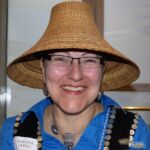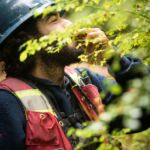To protect their national bird – stads k’un – the Haida are looking to the past for lessons on how the goshawks evolved, the habitats they needed to thrive, and the traditional stewardship practices that held the islands’ ecosystem in balance.
A Feather in the Forest: Haida Researchers Race to Protect Endangered Stads K’un (Northern Goshawks)
Estimated Reading time

35 Mins
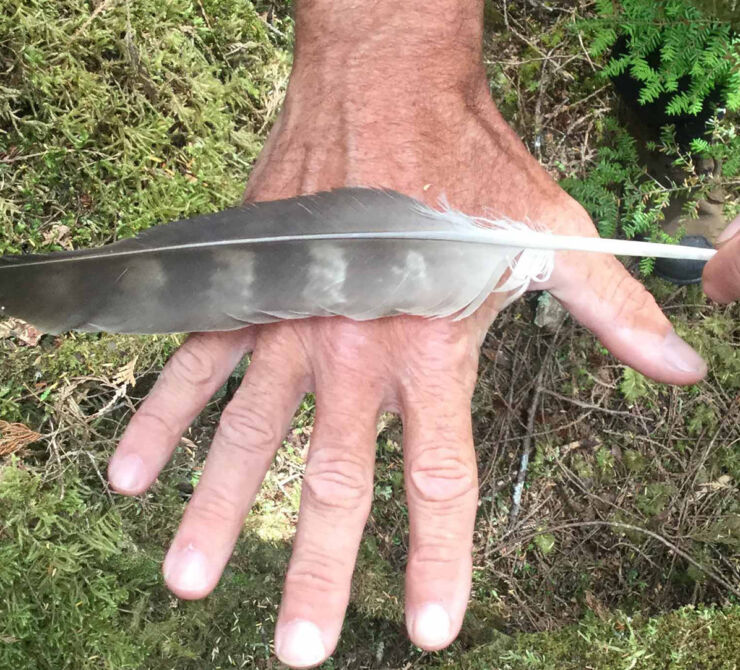
Haida people have called Xaayda Gwaay.yaay Haida Gwaii home since time immemorial. Their traditional territory encompasses the archipelago of Haida Gwaii, its surrounding waters, and parts of southern Alaska.
At a Glance
Haida surveyors and stewardship staff, along with biologists and researchers, are racing to identify and protect critical old growth forest habitat for the last remaining stads k’un, a subspecies of Northern goshawk that’s unique to the island archipelago.
Stads k’un, the national bird of Haida Gwaii, is a forest-dwelling hawk that’s evolved over thousands of years, adapting to thrive in the dense old growth forests that once covered the islands of Haida Gwaii. Genetically distinct from mainland goshawks, stads k’un reproduce more slowly and breeding pairs require large territories for foraging and breeding.
In modern times, logging and industrial activity have significantly reduced the availability and connectivity of old growth habitat for stads k’un. At the same time, invasive species like k’aad deer and daasGa Red squirrel have outcompeted local wildlife and dramatically altered the composition of Haida Gwaii’s forests, reducing the numbers of smaller birds that stads k’un rely on for food. Today, there are just 31 known nest sites, making it difficult for researchers to accurately gauge how many birds are left.
Since 2000, the Council of the Haida Nation’s Heritage and Natural Resources Department (formerly known as the CHN Forest Guardians) has conducted surveys, sending field workers out to check known nest sites and gather information on the birds’ behaviour, habitat needs, and interactions with other wildlife. Using this data, the Haida Nation works with the Province of BC to designate legal reserves around nest sites, protecting valuable stads k’un territory from logging and other activities.
Haida Gwaii’s National Bird
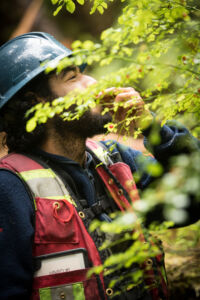
Jonas Prevost, a Haida citizen and stewardship technician, began working with the Haida Heritage and Natural Resources Department (HNRD) at the age of 17. He’s now in his mid-twenties, with a full beard, a wide smile, and a knack for using stories (and the occasional joke) to help Haida youth and new field workers understand the important role stads k’un play in his Nation’s culture and stewardship practices.
He’s spent eight seasons searching for signs of stads k’un, spending much of the spring and summer in k’aang hemlock and kayd spruce forests, binoculars in hand, looking for feathers, pellets, whitewash, and – most importantly – nests. With guidance from CHN researchers and community members, he’s honed his observational skills and developed an intuition for where to find the elusive stads k’un.
“I like to imagine these birds as kind of prim and proper and relatively picky,” he explains. “[Stads k’un] are hard to please, because they want the best: the biggest trees, the best foods, the nicest house. They want to be recognized down there on the block as the wealthy ones. And, to my delight, I get to go into those places to look for them.”


Stads k’un are accipiter hawks that have adapted over thousands of years to thrive beneath the canopy of Haida Gwaii’s old growth forests. They’re genetically distinct from the goshawks that live on the mainland, about 70 kilometres away, which are larger and tend to lay more eggs, more often.
“[They’re] beautifully accustomed to the ecosystems that developed since glaciation here on Haida Gwaii,” Jonas says. “We’re talking 14,000 years in isolation, so there are no genetic crossovers. They’re not going to fly across Hecate Strait and go to Canada to visit the [other goshawks.]”
I’ve seen [stads k’un] that are flying and twisting and they’re just like the most nimble little fighter jet of the natural ecosystem.
Stads k’un on Haida Gwaii are slate grey, with white chest feathers speckled with fine blue and grey streaks, and a proud white stripe over their eyes – “like they just got their brows done,” Jonas says. With their short, quick-beating wings and long tail that acts like a rudder, stads k’un can manoeuvre swiftly between branches and shrubs to snatch up prey.
“They are so agile,” Jonas says. “And it’s amazing to watch. I’ve seen [stads k’un] that are flying and twisting and they’re just like the most nimble little fighter jet of the natural ecosystem.”

In Haida culture, stads k’un are associated with “prestige and esteem,” Jonas says, recalling a story of a Chief who was presented with a young goshawk to mark the beginning of his chieftainship. “That was a representation of the importance, the esteem of not only what that bird represents, but also for that particular Chief’s [place in Haida society].”
With colonization, European settlers introduced clearcut logging practices and new species to Haida Gwaii, damaging and fragmenting the old growth habitat stads k’un rely on. As the number of stads k’un dwindled and sightings became rarer, the Haida asserted their stewardship responsibilities and collaborated with the governments of British Columbia and Canada to establish an inventory, protect nesting sites, and begin work to reverse the population decline.
In 2017, the Haida House of Assembly voted to declare stads k’un the national bird of Haida Gwaii. The declaration affirmed the Haida’s close relationship with the goshawk and unified the Nation in protecting their territory for the benefit of Haida people and the wildlife they’ve lived alongside for millennia.
A Changed Landscape

Kung K_ayangas Marlene Liddle, is a Haida citizen and serves as the Nation’s Director of Lands Stewardship, within the Heritage and Natural Resources Department (HNRD). In her role, she’s often working to source funding for stads k’un monitoring and to connect researchers from different governments.
The HNRD team includes researchers and surveyors who map cultural features and gather data on the health of the forests, fresh water, and habitat, as well as on the impacts of resource development, including logging. Using that data, Marlene and her team monitor the territory and recommend strategies for balancing the needs of communities, industry, and the ecosystem at large. Marlene’s team frequently collaborates with biologists from the Province of British Columbia and Environment and Climate Change Canada, and she leads a joint technical working group that reviews stads k’un research and develops strategies for protecting stads k’un habitat and managing its prey species.
“The Haida House of Assembly resolution gives our department the mandate to protect our national bird, stads k’un,” says Marlene. “To deliver on that mandate, the technical working group is drafting a recovery strategy and identifying foraging habitat.”
In order to plan a better future for stads k’un, the Haida and their partners often look to the past for lessons on how the goshawks evolved, what they needed to thrive, and how Haidas managed their territories alongside stads k’un.
Before colonization, the forests on Haida Gwaii were much more structurally diverse, with overlapping layers of trees of different heights and a thick understory of shrubs and plants that provided food for prey and cover for stads k’un.

“Haida never clear-cut anything,” Jonas says, explaining that his ancestors harvested with care, enhancing the forest and creating openings for sunlight to come through and help shrubs, berry bushes, and new trees to grow. “That selective harvest [and] forest management goes back thousands and thousands of years of living and interacting with an ecosystem that is very much intertwined with the culture and the people.”
“Back in the day, before we had deer here, there was a lot of understory in the forest [with] really high salal and huckleberry, and…lots of grouse around,” says Kiku Dhanwant, a researcher who lives near Masset and works for the Haida Nation. “It’s just all really convoluted, screwed-up ecology now.”
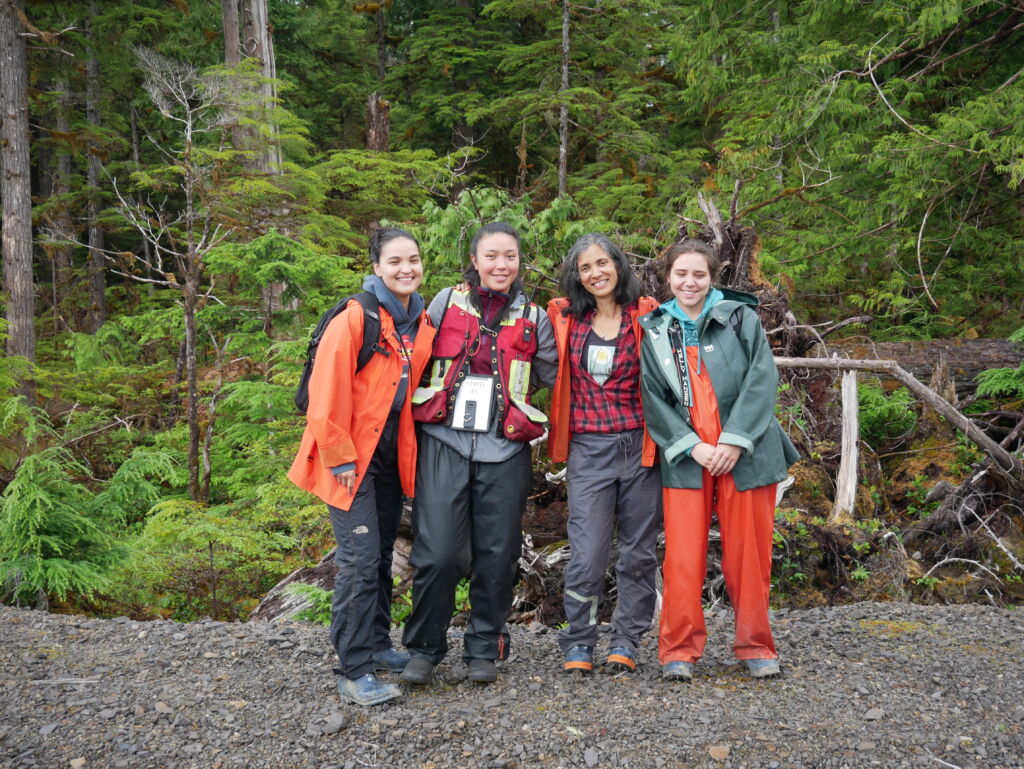
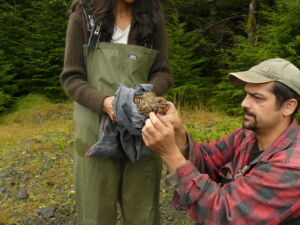
Born in India, Kiku migrated with her family to Vancouver when she was a child. After completing her degree in biology and environmental studies, she travelled to Haida Gwaii in 1996 as a part of the initial inventory efforts to locate stads k’un nests and protect their breeding territories. During this first year of walking the old growth looking for the elusive stads k’un, she met her late husband, Gerry Morigeau, who was part of the team that found the first protected nest at Bonanza Creek.
A member of the Ktunaxa Nation, Gerry grew up hearing stories of the Haida fighting to save old growth forests in the 1980s, and was drawn to Haida Gwaii. He was an important mentor for Kiku, Jonas, and other Haidas, sharing knowlege on the Nation’s stads k’un recovery efforts and teaching others how to look for signs of the elusive goshawks.
Kiku has lived on Haida Gwaii for decades, contributing her passion for Haida Gwaii’s forests and her biology skills to the Nation’s efforts to protect threatened species.
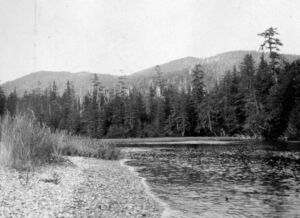
“Stads k’un are an amazing bird to study, helping us understand what First Nations talk about when they say everything is interconnected,” Kiku says. When Europeans arrived, they introduced k’aad deer and daasGa Red squirrel. Within a few generations, the k’aad spread through the main island, gobbling up the easy-to-reach plants in the forest understory.
“When you lose the understory, you lose all the leaf litter that’s falling to the ground, and all the berries,” explains Kiku. Fewer leaves on the ground means fewer insects, and fewer nutrients for bacteria and fungi in the soil, impacting soil productivity. And fewer berries and insects means fewer songbirds and skaw grouse, which stads k’un depend on for food.
“It affects everything from the ground up,” she says, raising her hands to indicate the layers in a healthy forest. “Looking at this bird and trying to understand its needs…helps us connect with what’s happened to the landscape over time.”

We can learn from what First Nations used to do, because they managed to live here for thousands of years. The world needs that example.
She credits Haida people, who have long understood the connections between living things and have used this knowledge to steward their territory, harvest selectively, and develop sophisticated cultural traditions and prosperous communities. Indeed, some of the stads k’un nests that have been found more recently are in the cedar stewardship areas where Haidas have harvested for many generations.
Kiku remembers a conversation with Gerry, who imagined what it must have been like for the stads k’un living alongside the Haidas to witness generations of Haida people harvesting trees for totem poles and carving canoes in the forests, year after year until smallpox reached the islands, interrupting a long pattern of coexistence. Now, something like that is happening to stads k’un, he said: another kind of epidemic.
“We can learn from what First Nations used to do, because they managed to live here for thousands of years,” Kiku says. “The world needs that example.”
Thinking Like a Goshawk
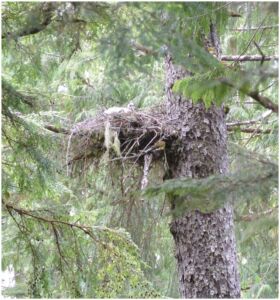
Years ago, Jonas had an opportunity to see firsthand what Haida Gwaii once looked like when Gerry, his mentor, brought him by boat to hunt k’aad on a small island in Gwaii Haanas, at the southern end of Haida Gwaii. Gerry and a group of seasoned hunters dropped Jonas off on the shore with his gear and instructions to meet them at a small bay on the other side of the island when he was finished hunting.
Eager to prove himself, a young Jonas climbed up the rocky shore and began hiking into the island in search of k’aad. “I get into the tree line, and it’s just this big, beautiful salal. I found a path through and I make it five, 10 meters into this island and I can’t see my feet, I can’t turn around, I can’t see the ocean around me. I don’t know where I’m going,” he recalls. “I can barely stretch my arm out in front of me to read [my compass.] It was so dense and thick and beautiful.”
“This island [was] only 50, 60 meters across. It took me an hour [to hike through it]. And I plopped down on the other side, sweating, bleeding and bruised, to see the bow of that boat full of the guys smiling from ear to ear [as they asked] ‘how many [k’aad] did he get?’” Jonas grins at the memory. “They knew there wasn’t a damn deer on that island. Never has been.”
That experience has helped Jonas to understand what his homeland once looked like, and the density and complexity of old growth forest that species like stads k’un need to truly thrive.
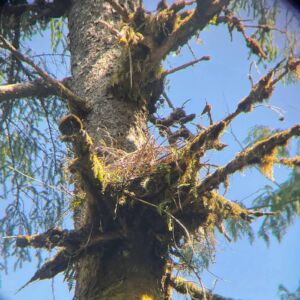
“I’ve never been in a place like that before. The birds, you can hear them everywhere, from the top of the canopy to underneath the salal. The island just buzzed and vibrated with the resonance of all these different bugs that I’ve never seen before. The huckleberry trees were as thick as my forearm, 25 feet tall and fruiting. They look like grapes at the top of this tree,” Jonas says. “And I realized that that’s what I’m fighting for.”
In his work on stads k’un, Jonas and his colleagues use GIS maps, which combine satellite imagery with ground-level monitoring data, to find spaces on Haida Gwaii that have the necessary attributes – old growth trees, shrub layers, fewer human impacts – for stads k’un breeding and foraging habitat.
“Once you take that full-scale, zoom out of all of Haida Gwaii, and you look at it on a map or a GIS program, we’re really trying to define ‘what is good habitat?’,” he says. “I’m not a goshawk and I don’t know, but I can take a really good guess.”
After over a century of logging, potential goshawk habitat has thinned. The Haida Gwaii Land Use Plan, published in 2007, notes that over the past 100 years, “more than 100,000,000 cubic metres of trees have been logged and shipped from Haida Gwaii… enough wood to circle the planet with a single six-foot-wide log worth over $15 billion dollars before milling, manufacturing and resale.”
Under the Land Use Plan, about 48 per cent of the land base is protected from new logging, though it will take decades for second growth forests to mature. Beyond the direct impacts of logging, potential stads k’un habitat has been criss-crossed with roads, pocked by cut blocks, and altered by k’aad. Each of these changes disrupts the ecosystem, making it more challenging for stads k’un to recover.
We’ve walked a lot of Haida Gwaii and have found 31 nesting sites which, over time, have received some protection for the breeding area, but not the foraging area yet.
Over the winter months, Jonas, Kiku, Marlene and the HNRD crews spend time analyzing maps and plan for the next season of field work, which usually runs from April to August , closely mirroring the stads k’un breeding cycle. In the last year, HNRD stewardship technicians extended their field season, checking known sites during the winter months to monitor stads k’un prey and activity.
“We’ve walked a lot of Haida Gwaii and have found 31 nesting sites which, over time, have received some protection for the breeding area, but not the foraging area yet,” Kiku says, noting these protections are limited. “We still keep doing the work to collect the data that’s necessary to come up with strategies to manage habitat that they require to survive.”
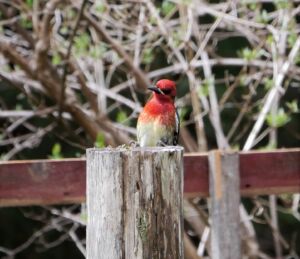
Last summer was a tough season – Jonas didn’t find any goshawks, despite return visits to sites where he’s found feathers and nests in the past. With so few stads k’un remaining, Jonas says the HNRD has to protect every site that’s shown signs of goshawk activity.
That same summer, one of Jonas’ colleagues, Ben Reindel, found an active nest during an archaeological survey of second growth forest. The site held all the signs of goshawk activity – whitewash, pellets below the nest, downy feathers from chicks using the nest, prey remains. Sadly, the only stads k’un the team found was a dead chick near the nest. For young goshawks looking for suitable nesting sites in thinning forests, predators like raccoons and martens can be a major threat.
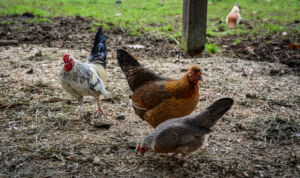
Tools for Monitoring Stads K'un
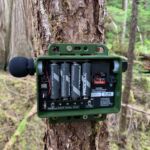
Audio Recording Units:
These recording devices can pick up the calls of the forest, within a range of several hundred meters. CHN crew members place recording units near known nest sites and in suitable habitat.
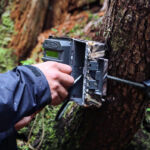
Motion-Activated Cameras:
Strategically positioned, these cameras are triggered by motion, capturing crucial images and videos for ongoing stads k’un research. Gathered footage helps researchers better understand goshawk behavior and habitat usage.
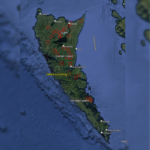
Mapping and Identification Surveys:
Field technicians and researchers conduct surveys throughout Haida regions to map and identify potential stads k’un nesting sites.
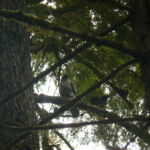
Simulated Goshawk Calls:
HNRD field surveyors use simulated goshawk calls to attract birds and identify territories and nesting sites.

Careful Observations:
Field researchers and technicians meticulously observe their environments while walking many kilometers through the old forests, looking for indicators such as prey remains, white wash, and feather piles.
Protecting Nest Sites
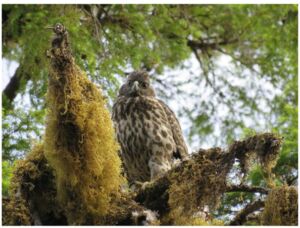
With just 31 known stads k’un nesting sites – and not all of them active – there’s a moral imperative to protect remaining habitat, says Berry Wijdeven, a retired planner who immigrated from the Netherlands and has lived and worked on Haida Gwaii for many years. During his career as a species at risk coordinator for the Province of British Columbia, Berry coordinated research and inventory work on stads k’un, as well as other threatened species, like marbled murrelets, Northern Saw-Whet owls, and great blue herons.
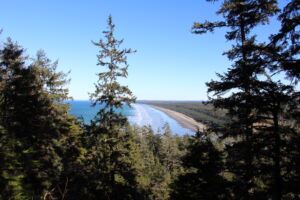
In the last year, the Haida partnered with the Province to develop a recovery strategy for stads k’un, which is closely linked to the Haida Gwaii Land Use Objectives Order. Under the Order, when surveyors locate a goshawk nest or probable breeding site, the Nation designates a 200-hectare reserve, protecting the immediate surroundings from logging and resource development.
They need every acre of protection they can get.
“They need every acre of protection they can get,” Berry says, noting that these buffers are just enough to protect the nests and fledgling area, but don’t cover a goshawk’s full foraging territory, which can be as large as 9,000 hectares. He also shared that the reserves can cover any adjacent forest, which may or not include enough of the old growth habitat that stads k’un require.
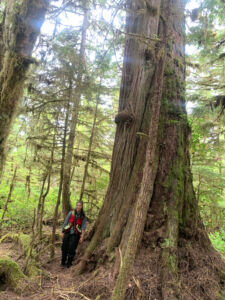
Under the current forestry model, when goshawk reserves are taken out of a forest tenure, forestry operators will look to make up for that loss somewhere else. This can increase habitat fragmentation, potentially reducing nest site availability elsewhere.
“It’s very difficult and we always try to strike a balance between the needs of the goshawk and the needs of society,” he says. “Looking back now, I think we were overly cautious in striking that balance, where we kept trying to figure out methods or protection percentages that were acceptable from a socio-economic perspective.”
Stronger Protections
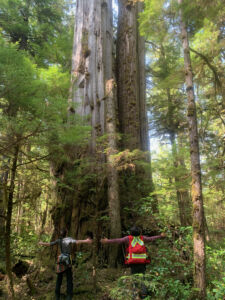
Stads k’un are on the brink of extinction. To save them, Berry and Kiku say that the goshawks require larger protected areas that include old growth forest or mature second-growth forests with habitat suitable for nesting and foraging.
One path forward is through Canada’s Species at Risk Act. If the Committee on the Status of Endangered Wildlife in Canada (COSEWIC), an independent group of scientists, designates a species as ‘endangered’, then provinces are required to develop a recovery plan and strategy, which could include further steps to protect habitat. If the federal government believes that a province’s measures are insufficient, they can step in.
Right now, COSEWIC lists stads k’un as ‘threatened,’ though the committee will meet again in April to review the evidence on stads k’un (and other threatened species) and determine whether to designate the species as ‘endangered.’ (In BC, stads k’un are red-listed, meaning a species at risk of being lost, though BC does not have its own endangered species act.)
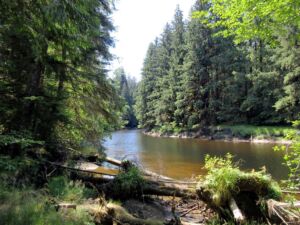
In the meantime, the Haida are working through their own forestry company, Taan Forest, to bring back Haida values in the stewardship of second-growth forests, which could someday become suitable habitat for stads k’un.
“That’s where there’s this huge opportunity to start restoring the landscape,” says Kiku. “Take some of the trees – not all of the trees – and then start managing the landscape for the coast, which is to mimic natural disturbance, where you have small openings, that’s where goshawks could thrive. And bringing back the understory, taking out the deer, and introducing more snags.”
If this went unchecked for another 100 years, what would that look like?
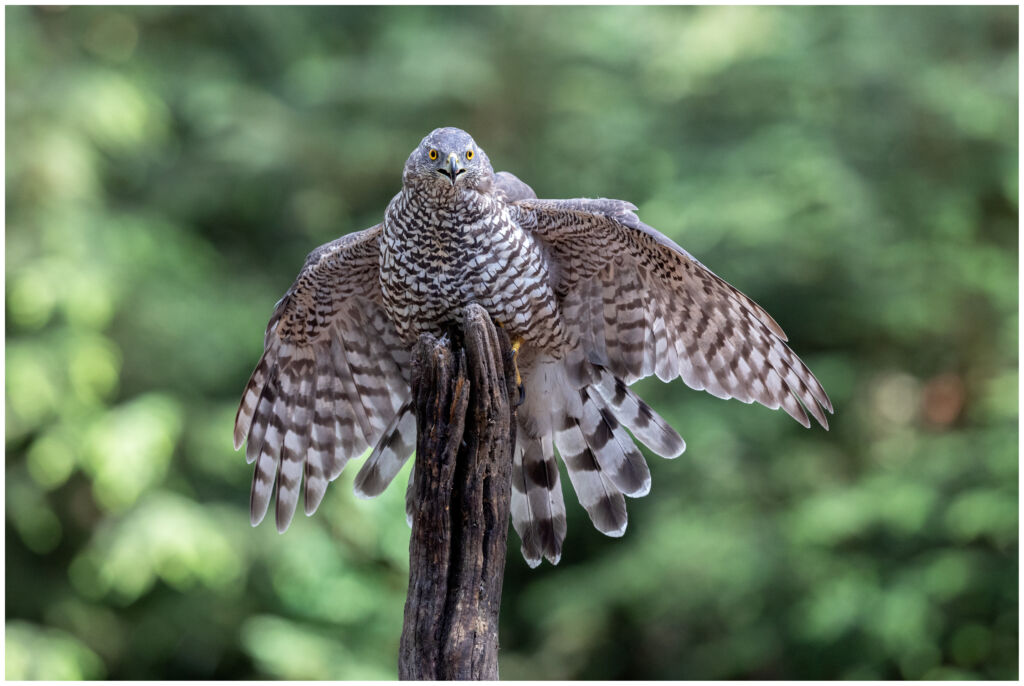
“It’s a process. And, just like any other process, it takes time. But right now, we don’t have time,” Jonas says.
“We need to protect what is left, in terms of habitat, our forests, our ecosystems, our land. We’re talking about a single species to manage for a single aspect of what that forest sustained. And I think there’s so much more to it, you know, the connections between each species are there. And everything relies on everything else. And, it’s really hard to imagine if this went unchecked for another 100 years, what would that look like?”
Through the Coast Conservation Endowment Fund Foundation, the Council of the Haida Nation has invested $2,413,780 from 2017 to 2023 for stewardship activities, including monitoring, GIS mapping, and recovery strategy development for stads k’un and other species. The Province of BC and Government of Canada have also contributed funding for stads k’un and marbled murrelet monitoring.
Links
- Council of the Haida Nation
Wings Brushing Boughs: Stads K’un named Haida Gwaii’s national bird - The Narwhal
In search of Haida Gwaii’s forest-dwelling hawk, one of the most endangered species on the planet - Taan Forest
Protecting and Managing Haida Gwaii Goshawk - Canadian Press
Haida Gwaii home to a distinct but vulnerable pocket of northern goshawks - Haida Gwaii Observer
On the Wing: In Praise of Goshawks and Forests - Province of British Columbia
Northern Goshawk - Spicies at Risk Public Registry
COSEWIC Assessment and Update Status on the Northern Goshawk (2000) - Evolutionary Applications Journal
Population genomic analyses reveal a highly differentiated and endangered genetic cluster of northern goshawks (Accipiter gentilis laingi) in Haida Gwaii (2017)
Published On March 14, 2024 | Edited On August 1, 2024
